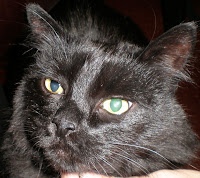
This week's case of the week is actually about two young cats from two different families with a similar problem that we saw in the past week. Both of the cats had ear mites and had been treated for them but were still scratching at their ears. The owners were concerned that their cats still had the ear mites.
When I examined each of them, the ear canals were so full of waxy discharge that I could barely see into the ears. We looked at the discharge under the microscope but could not find any mites. We then did a smear of the discharge and put on a stain that helps us see any cells, bacteria, or yeast. By looking at these under the microscope, I found that both cats had large numbers of yeast. We cleaned the ears well and I prescribed medication to place into the ears, which will clear up the infection.
Ear mites are parasites, called Otodectes, that live in the ear canals of cats, dogs, rabbits and ferrets. They are very contagious and are spread with close contact of animals. They cause itching of the ears, which can be quite severe in some cats. A large amount of wax builds up in the ear canals. When the cat scratches at his ears with his hind claws, he can cause damage to the skin, from small scabs to deep scratches that can become infected.
In some cats, I can see the ear mites moving around in the canal when I look in with my otoscope. If I can't see them but I suspect they are there, we take some of the discharge and place it on a slide so we can look under the microscope. If ear mites are present, we can see them moving on the slide. In some cases, we will also see the mite eggs under the microscope.
Ear mites are usually easily treated with medications prescribed by a veterinarian. There are medications that go directly into the ear or onto the skin, which then spreads to the ears to kill the mites. These products are very effective and I rarely see a case where the mites are not completely resolved after one treatment. I have, however, seen many cases in which an over-the-counter medication was tried and did not kill the mites. These over-the-counter drugs are not nearly as effective as the medications available from a veterinarian.
Ear mites, however, can still cause problems even after they are gone. It is not uncommon to see cases like these two kittens in which the cat continues to scratch after ear mite treatment. These are usually due to bacterial or yeast infections. These will occur because of the moist environment in the canals resulting from the waxy build-up cause by the mites. These are a little more difficult to treat but usually resolve well with ear cleaning and the proper medication applied into the ears for several days.
There are other problems as well that cause ear discomfort and discharge. If you notice discharge or see your cat scratching at her ears or shaking her head, have your veterinarian examine your cat and look at the discharge under the microscope (called cytology). Many over-the-counter medications do not work or cause further irritation and may not be addressing the real cause of the problem. It is better for your veterinarian to determine the cause and prescribe the proper treatment so you can resolve your cat's discomfort.
You can find more information in the LifeLearn Library on our website.
Dr. Judy Karnia




















